The iPad Air Review
by Anand Lal Shimpi on October 29, 2013 9:00 PM ESTiPhone to iPad: CPU Changes
Although the iPad Air uses the same A7 from the iPhone 5s (and M7 motion coprocessor), there are a few minor differences that do lead to better performance.
At a high level we’re still talking about two 64-bit Apple Cyclone cores with 128KB L1s (64KB I$ + 64KB D$) per core, a shared 1MB L2 cache and a 4MB L3 cache that services the entire SoC. Apple increased CPU frequency from 1.3GHz to 1.4GHz in the iPad Air, a mild increase but in line with what we’ve seen from previous iPad designs. That’s the first impact on performance - a 7.69% increase in CPU frequency.
The second impact on performance is something I only noticed while digging around under the hood of the A7. It seems like the implementation in the iPad Air can, for whatever reason, hold more instructions in flight (over 20% more) than the A7 in the iPhone 5s. It’s unclear to me whether the A7 in the iPad is configured any differently via firmware/microcode or if perhaps we’re looking at a slightly different revision of the core, but the delta was repeatable in my testing.
The third, and likely biggest change impacting the iPad Air’s implementation of the A7 is the additional thermal headroom afforded by the larger chassis. I’m not going to go into details on exactly what this next test does (unfortunately we’re going to occlude some of the low level work that we do in light of all of the benchmark cheating going on), but we’re looking at a curve of performance vs. time for a particularly power heavy mix of code. We’re running the same exact code on both the iPad Air and iPhone 5s here, the only real difference is the size of the chassis:
You can see the 5s throttles back its CPU frequency to about 1GHz after the 2 minute mark. The crazy thing is that until that point the 5s manages to run at full frequency without so much as a hiccup for two full minutes, running an incredibly power hungry task. Given that most iOS apps aren’t this power intensive for such a sustained period of time, iPhone 5s users should almost always see the A7 running at a full 1.3GHz. Pretty crazy.
The iPad Air by comparison shows much more controlled behavior. Early on in the test we see a 7.7% performance advantage, which lines up perfectly with the iPad Air’s 7.7% CPU frequency advantage. By the end of the test the iPhone 5s has throttled to 900MHz, while the iPad Air drops to around 1.2GHz. At this point the iPad Air’s performance advantage grows to almost 40%.
CPU Performance
I've gone through our standard set of cross-platform browser based benchmarks to place the iPad Air's performance in perspective. As I mentioned in our 5s review, I don't know that there are many (any?) applications on iOS 7 that can really take advantage of all the A7 has to offer. There's definitely a ton of headroom left in the design. What's particularly exciting is when the A7 ends up in n-1 or n-2 iOS devices and it becomes the minimum developer target going forward.
I won't go through all of the results here again, but it's safe to say that the iPad Air is the fastest ARM based tablet on the planet at this point.
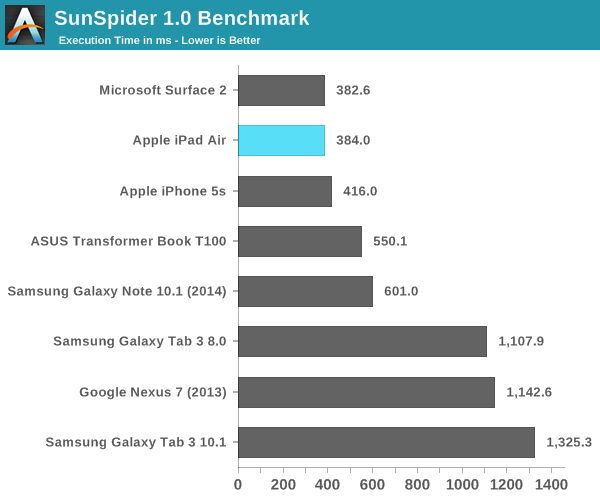
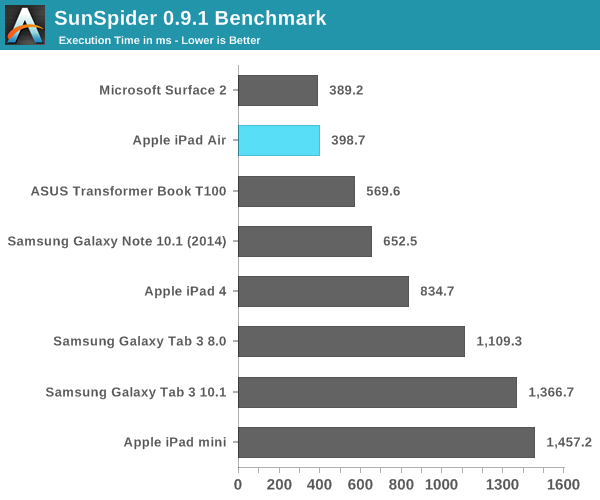
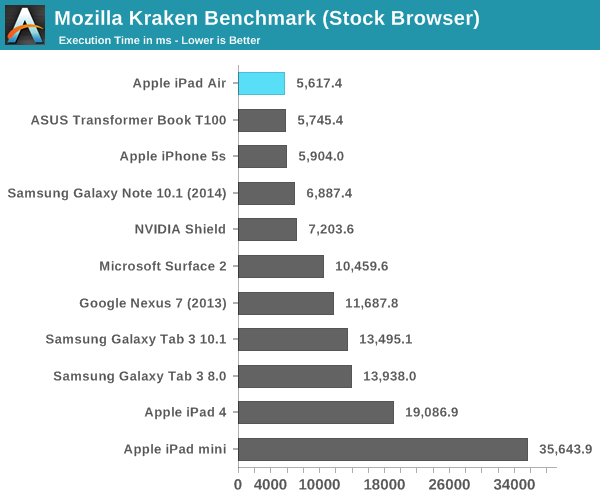
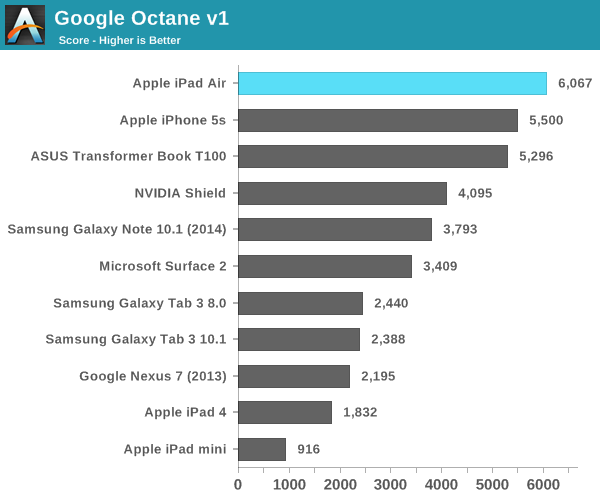
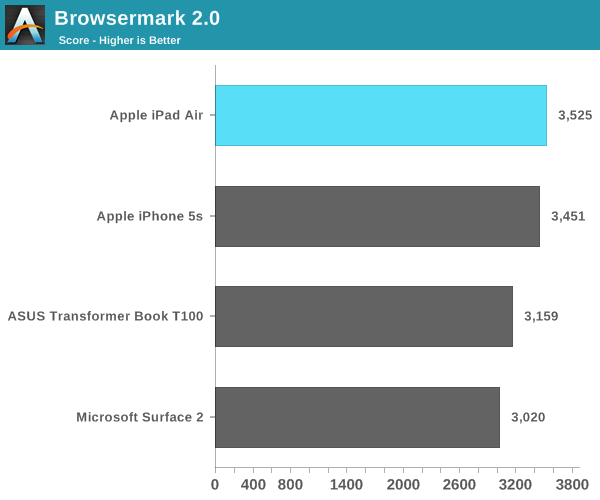

A7 Power Consumption
I’ll get to battery life in a bit, but I’ve been curious about the dynamic range of power consumption offered by Apple’s new A7 SoC. On the one hand we’re dealing with a lower power process (28nm vs. 32nm), but on the other hand Apple’s Cyclone cores can clearly draw more power given how beefy the architecture is this round. Apple frowns upon review sample dissection so I had to turn to a less scientific method of external platform level power measurement. The fidelity of the numbers here aren’t all that great but it’s better than nothing.
For the first test I measured platform power consumption during a Kraken run:
I purposely started measuring before the benchmark so I could get an idea of idle power consumption. The iPad Air consumes roughly 72% of the idle power as the iPad 4, both running at the same brightness. Here we’re not just seeing the A7’s advantages but also things like lower display power.
Focusing on the load portion of the measurement we see that both the new iPad and old iPad consume the same total power in this test. I suspect the A7 is drawing more power than the A6X, but it’s masked by a lower power display. Given how much faster the iPad Air is, Apple’s latest tablet features far lower overall task energy than the outgoing iPad 4. This is probably both the best case scenario for the iPad Air and the most likely case as well.
For kicks I wanted to see just how much power I could get the iPad Air to draw. Here I’m looking at platform power during our mini-power-virus test from above:
How’s that for dynamic range? Almost 12W running all out, but around half that in what we’d normally consider to be a stressful CPU test. I couldn’t get any actual applications/games on the iPad Air to behave like this so the results above are purely academic (for now). A quick run through GFXBench 2.7’s T-Rex HD test confirms that even pushing the GPU won’t hit these numbers. The max I saw running T-Rex offscreen was ~6W, and turning to an actual game (Infinity Blade 3) the iPad Air pulls less than 5W.


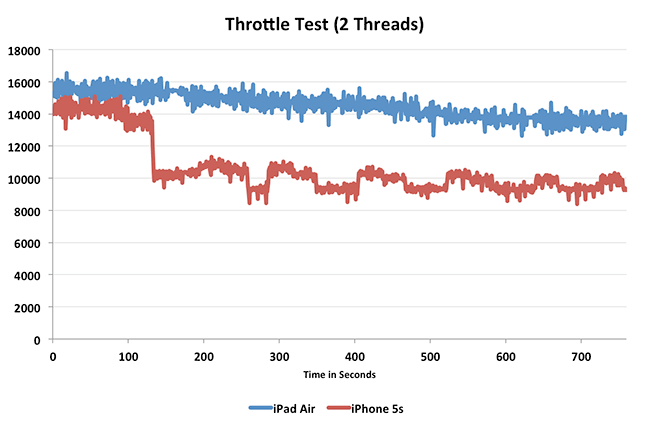
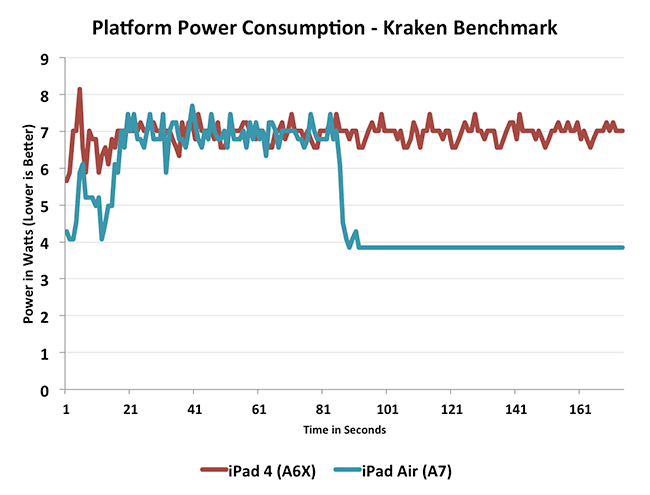
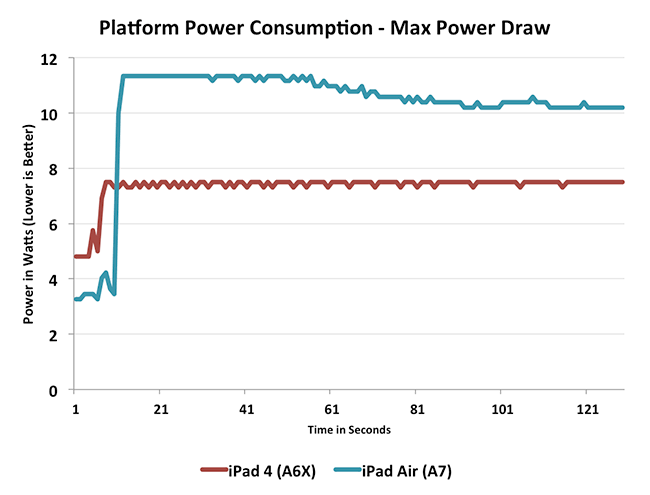








444 Comments
View All Comments
michal1980 - Wednesday, October 30, 2013 - link
Did you read? I was talking about windows 8.1, you know the big upgrade given away 2 weeks agoI know that in iSheep land windows doesn't exist.
abazigal - Saturday, November 2, 2013 - link
He's probably writing it even as we speak, and it will likely be posted in a matter a time.Anand has a ton of devices to review, so they have to set a priority. Not to mention that he has pretty much stated that he works on an iMac, so I imagine using Win8 actually takes away from his productivity time.
algalli - Wednesday, October 30, 2013 - link
Your right Windows 8.1 will be used by tens of people not hundreds of millions of people, at least in the tablet worldjecastejon - Wednesday, October 30, 2013 - link
And by the same standard, objectiveness and evidences you present I say you are paid by Apples's competitors.darwiniandude - Wednesday, October 30, 2013 - link
Really?? Strange... The detailed review I just read complained (politely) about Apple not letting them dissect (cut open) review (loan) units. It also mentioned GUI performance frame rate drops in the multitasking UI and complained that due to 64bit they really need to ship with 2GB ram rather than the 1GB they come with. I can guarantee most other reviews out there will not mention these particular technical negatives. Anandtech reviews are thorough.Rickschwar - Thursday, October 31, 2013 - link
Although I haven't seen too much Apple bias from AnandTech in the past, this is one of the most biased reviews I have ever read. This is surprising because normally AnandTech is the “gold standard” for all things technical. The reviewer talks about the iPad Air like it’s a revolutionary product, when there is little new about it. Apple was playing catch up in many ways and other tablets have many advantages over it. For example, the iPad 4 was thicker than many Android tablets. In fact, at least ten Android tablets were thinner than the iPad 4. The Air is only 1.9 mm thinner than the iPad 4 and tablets like the older Sony Experia Z are still significantly thinner than the iPad Air is (7.5mm vs. 6.9mm). Of course this wasn't mentioned in the article. Even when it comes to weight, the iPad Air isn’t dramatically lighter than the Experia Z (469g vs. 495g). That’s not mentioned in the article either.Since I’m in the market for a new tablet and I’ve owned two iPads in the past, I was hoping for big things with the new iPad, but for me and others it was a “meh” release. The same old display, the same A7 processor, and little real innovation. CNET agrees saying “Functionally, the iPad Air is nearly identical to last year’s model, offering only faster performance and better video chatting.”
The most ironic part for my is the fact than more 90% of this article is based on benchmarks -- even though AnandTech has made it clear how easy it is to game benchmarks and others (including an article I wrote over a year ago published at Mostly-tech.com) have made compelling cases that benchmarks do not predict real world performance. This article mostly ignores real world performance and pretends that Android tablets don’t exist.
After this article I will never look at AnandTech the same again. At least the CNET and Engadget reviews covered some of the limitations of this product.
- Rick
abazigal - Saturday, November 2, 2013 - link
The ironic thing about your statement is that for the moment at least, only Android OEMs have been found guilty of gaming benchmarks, not Apple. So doing any benchmark tests at this juncture would actually favour Apple's competitors, despite this being a review of an Apple product. So I don't see what reason you have to complain, when the odds are stacked in Android's favour anyways.Besides, Anand has thoroughly dissected the A7 chip in his 5s review, and concluded that it is actually faster and more power-efficient compared to the higher-clocked, quad-core processors found in Android phones and tablets. The fact remains that Android and most mobile apps generally aren't optimised with 4-cores in mind either. So for all intents and purposes, Android tablets may as well not exist, since they will likely lose to the iPad in terms of real-world performance anyways.
Also, the thing with these products is that they are ultimately a package deal. People don't just look at 1 single defining factor and buy a device based solely on that. Likewise, I am definitely not going to blindly buy the thinnest tablet in the market without first considering other factors like specs and availability of apps. You are not going to find that mythical Android tablet which is thinner, lighter, has a longer battery life, better screen, while boasting a larger market of apps and content.
I am sorry, but you are not going to find a more objective and detailed review anywhere else. You want the iPad air to be bashed, go hand out at some pro-android forum instead.
ADGrant - Saturday, November 2, 2013 - link
"Same old A7 processor". You look like a complete idiot when you post something like that. The A7 was announced less than a month ago.sunflowerfly - Thursday, October 31, 2013 - link
Anand biased? I do not believe that. They have no trouble pointing out Apple's flaws, and every product has them, nothing is perfect. The best products should win, and right now that happens to be Apple a lot of the time.ssiu - Tuesday, October 29, 2013 - link
No 2GB RAM; hope dashed :(Does that mean an iPad 4 (which can only run 32-bit code) will end up "less RAM starved" than iPad Air running 64-bit code?